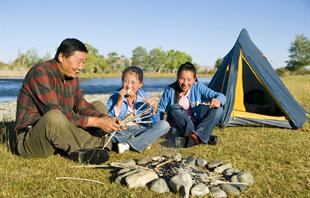Indigenous Peoples of Canada
 Indigenous children aged 14 and under make up 26.8% of the total Indigenous population. Non-Indigenous children aged 14 and under represented 16.4% of the total non-Indigenous population. (www12.statcan.gc.ca)
Indigenous children aged 14 and under make up 26.8% of the total Indigenous population. Non-Indigenous children aged 14 and under represented 16.4% of the total non-Indigenous population. (www12.statcan.gc.ca)
Indigenous children aged 14 and under in Canada lived in a variety of arrangements, primarily in families with either both of their parents or with lone-parents. Other Indigenous children in that age group were stepchildren, grandchildren living with grandparents with no parent present, foster children or children living with other relatives. (www12.statcan.gc.ca)
Over one-half of Indigenous children aged 14 and under (57.5%) were living in a family with both their parents, either biological or adoptive, compared with 81.4% of non-Indigenous children. About one-third of Indigenous children (31.5%) lived in a lone-parent family compared with 17.8% of non-Indigenous children. (www12.statcan.gc.ca)
The 2006 Census found that Indigenous people were much more likely to live in dwellings that were in need of major repair. For First Nations people, 29% lived in a home in need of major repair, up from 26% in 1996. Métis people were the only identity group to see a reduction in the past decade. The proportion of Métis people in homes requiring major repair decreased from 17% in 1996 to 14% in 2006. The Inuit population showed the largest increase in the proportion of people in homes needing major repair. In 2006, the proportion rose to nearly 28% from 19% 10 years earlier. In 2006, 7% of the non-Indigenous population were living in homes in need of major repair, compared to 8% in 1996.
Nearly half (45%) of First Nations people living on reserve in 2006 lived in homes that they identified as needing major repairs, compared to 36% a decade ago. With little change from 1996 to 2006, 17% of First Nations people living off reserve indicated that their homes were in need of major repairs.
Between 1996 and 2006 the Indigenous population grew at a much faster rate than the non-Indigenous population at 45% and 8% respectively. The Métis had the highest growth rate of all Indigenous identity groups with their population nearly doubling between 1996 and 2006. The First Nations population grew by 29% while the Inuit population grew by 26%. The growth rates for each of the Indigenous identity groups were much higher than that of the non-Indigenous population at 8% from 1996 to 2006.
Projections suggest that the Indigenous population could increase to approximately 1.4 million by 2017 from 1.1 million in 2006. The proportion of the Canadian population that identify themselves as Indigenous is projected to increase to 4% in 2017 from 3% in 2001.
There are several factors that can contribute to the higher growth rate for Indigenous peoples, such as higher fertility rates. There is also an increasing tendency for people to identify themselves as Indigenous in recent years which also contributes to this faster growth. (Stats Can).